In the upcoming edition of the UEFA European Under-21 Championship final tournament, which will be held in Georgia and Romania, Belgium will participate in Group A with the host nation, Georgia, and two big ones, Portugal and the Netherlands.
Unfortunately, Belgium U21, which had a golden generation in the previous decade, failed to live up to expectations and achieve notable success in recent tournaments as they now embark on a new era.
They are not considered a frontrunner in the tournament, Belgium lacks an extensive history in the competition, having failed to qualify in 2021. Their most notable achievement to date was reaching the semi-finals back in 2007. However, this limited success could serve as motivation for the team to strive for new accomplishments.
The Young Devils boast some promising young players like Largie Ramazani and Roméo Lavia, the latter of whom has featured 28 times in the English Premier League for Southampton this season.
This scout report in the form of a tactical analysis will provide a detailed analysis of Belgium’s tactics under Jacky Mathijssen.
Predicted starting XI
In recent years, the Belgian national team has predominantly relied on three-backline formations as their foundation. While there might be a slight shift in this trend, on paper, coach Jacky Mathijssen often alternates between the 3-5-2 and 3-4-3 formations, occasionally employing a 4-2-3-1 with a dynamic turn to 3-4-3.
In goalkeeping, the choice ranges between Maarten Vandevoordt, Senne Lammens and Maxime Delanghe. However, if Vandevoordt is deemed fit, Genk’s goalkeeper and the future goalkeeper of RB Leipzig will be the first choice in this tournament.
The backline requires dynamic centre-backs, such as Ignace Van der Brempt, Ewoud Pletinckx and Koni De Winter.
In midfield, the coach relies a lot on Aster Vranckx as a pivot; his partner changes according to the dynamics, but given his recent impressive performances, Roméo Lavia could be one of the exciting surprises that Belgium is counting on, though Anass Zaroury may also represent an essential tool in the coach’s back pocket.
On the flanks, Matisse Samoise and Maxim De Cuyper are preferred for the right and left wing-back positions, respectively.
The front trio of Largie Ramazani, Michel-Ange Balikwisha, and Yorbe Vertessen brings speed and mobility to the Belgian team’s vertical approach.

Jacky Mathijssen’s possible choices are the foundation of Belgium’s future first national team.

Jacky Mathijssen has crafted a formidable team, skillfully tailored to his fast-paced, vertical playstyle. The squad boasts a remarkable concentration of exceptional young talent, with a particular emphasis on players in the 21-year-old range.
This strategic selection ensures a harmonious blend of youthful energy, agility, and adaptability, perfectly aligning with Mathijssen’s desired approach on the field.
Attacking style
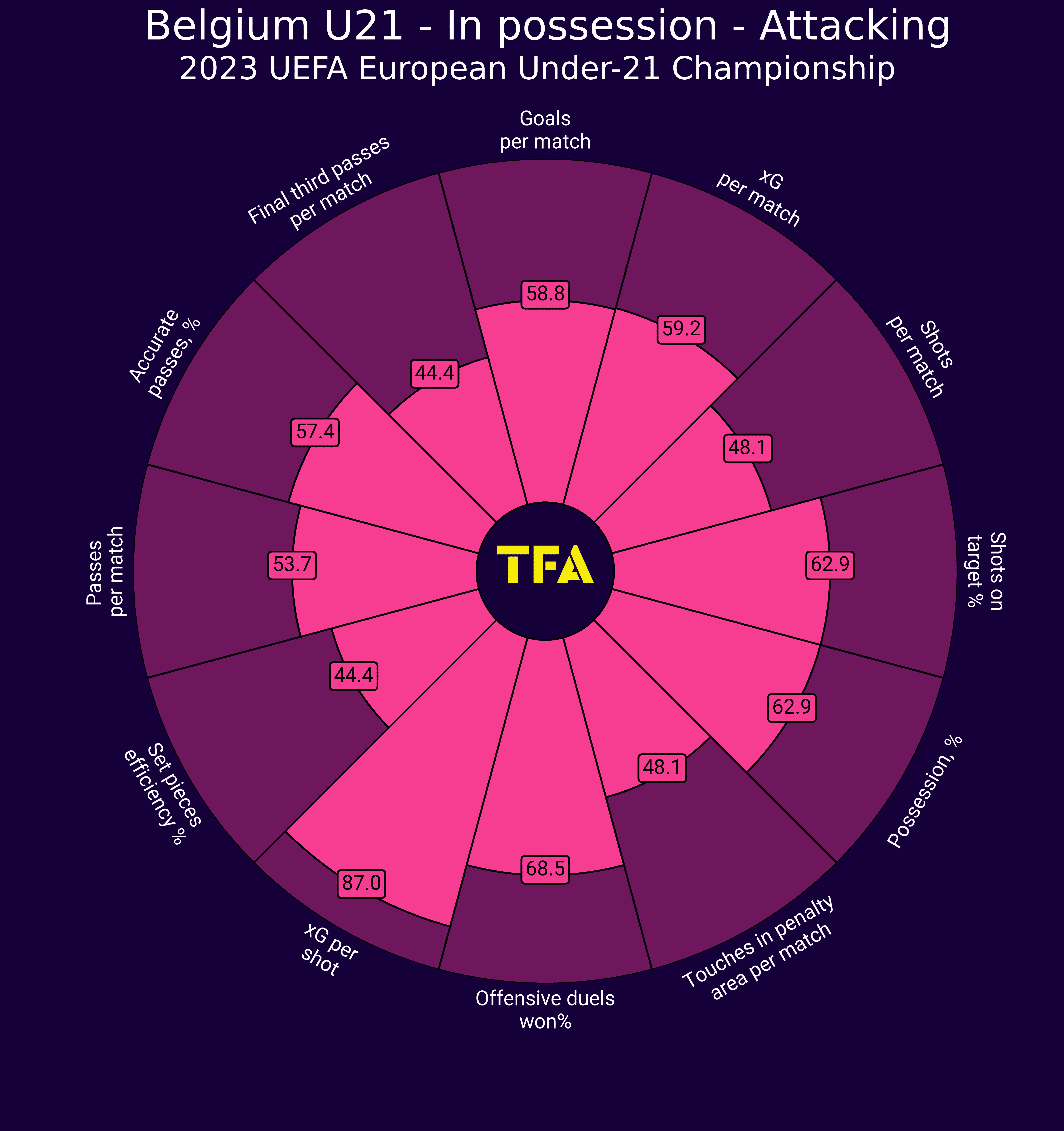
The statistical data presented offers valuable insights into the team’s playing style. With a possession ranking in the 62nd percentile, it becomes evident that they prioritise other aspects of the game over maintaining extended periods of ball control.
Moreover, their reduced number of touches in the opponent’s penalty area, ranking in the 48.1 percentile, along with their 87th percentile xG per shot, highlight their ability to swiftly reach high-quality scoring areas with minimal passes.
This efficient approach to attacking play is further reflected in their 53.7th percentile ranking for the fewest number of passes required to access these crucial zones. Collectively, these statistics paint a distinctive picture of the team’s playing style and their preference for direct, incisive attacks.
Furthermore, their goals-per-game ratio ranks in the 58.8 percentile, indicating a respectable ability to convert scoring opportunities into goals. Additionally, their proficiency in hitting the target is reflected in their ranking in the 62.9th percentile for shots on target, highlighting their accuracy when aiming for the goal. These statistics further illustrate the team’s effectiveness in creating and capitalising on scoring chances.
In their quest for vertical play and a focus on quick attacking transitions, Belgium employ an asymmetrical shape during the build-up phase, regardless of whether they use a three-person backline or a four-person backline.
They create a 4-2-4 or 4-3-3 base, as the wide centre-back (often the right) moves to be the fullback meanwhile the near wingback steps up higher into the flank.
Here below, against the Netherlands, Belgium operated with a 4-2 base as the right centre-back moved wide which created the 4-2-4 (one off the front line ready to drop off to add a +1 passing option).

Against France’s high pressing, the Belgian team utilised this tactic.

Verschaeren dropped off to receive the ball and quickly turned in a fluid movement before passing it next to Matazo, who finds Zaroury high and wide.

Meanwhile, France’s centre-backs were busy with Nkuba, as Verschaeren is moving vertically gaining dynamic superiority over his marker.

Verschaeren was found by Zaroury behind the backline and scored to put his team into the lead.

In contrast to the potential man-marking pressing approach, Belguim’s goalkeeper may play longballs toward the last line where there is a favourable 3v3 scenario with ample space. This strategic decision takes advantage of the mobility and superiority of Belgium’s mobile strikers.

During the progression and final third phases, Belgium adopt a direct playing style with a flexible 3-2-5 structure featuring dynamic movements from the front trio.
One of the pivots often showcases mobility by dropping deep to receive the ball, contributing to the team’s wide dynamic movements.
Below Zaroury dropped off to receive the ball while the left wingback De Cuyper moved diagonally towards the midfield. At the same time, the inside winger Jérémy Doku drifted wide — this dynamic and fluid movement can easily confuse opponents and lead to positioning mistakes.

For example, against the Netherlands, the Belgian players executed similar dynamics. Doku drifted wide and received a pass behind the opposition’s defensive line, while Zaroury pinned the opponent’s fullback.


Later Doku cut the ball to Deman who scored.

Defensive play
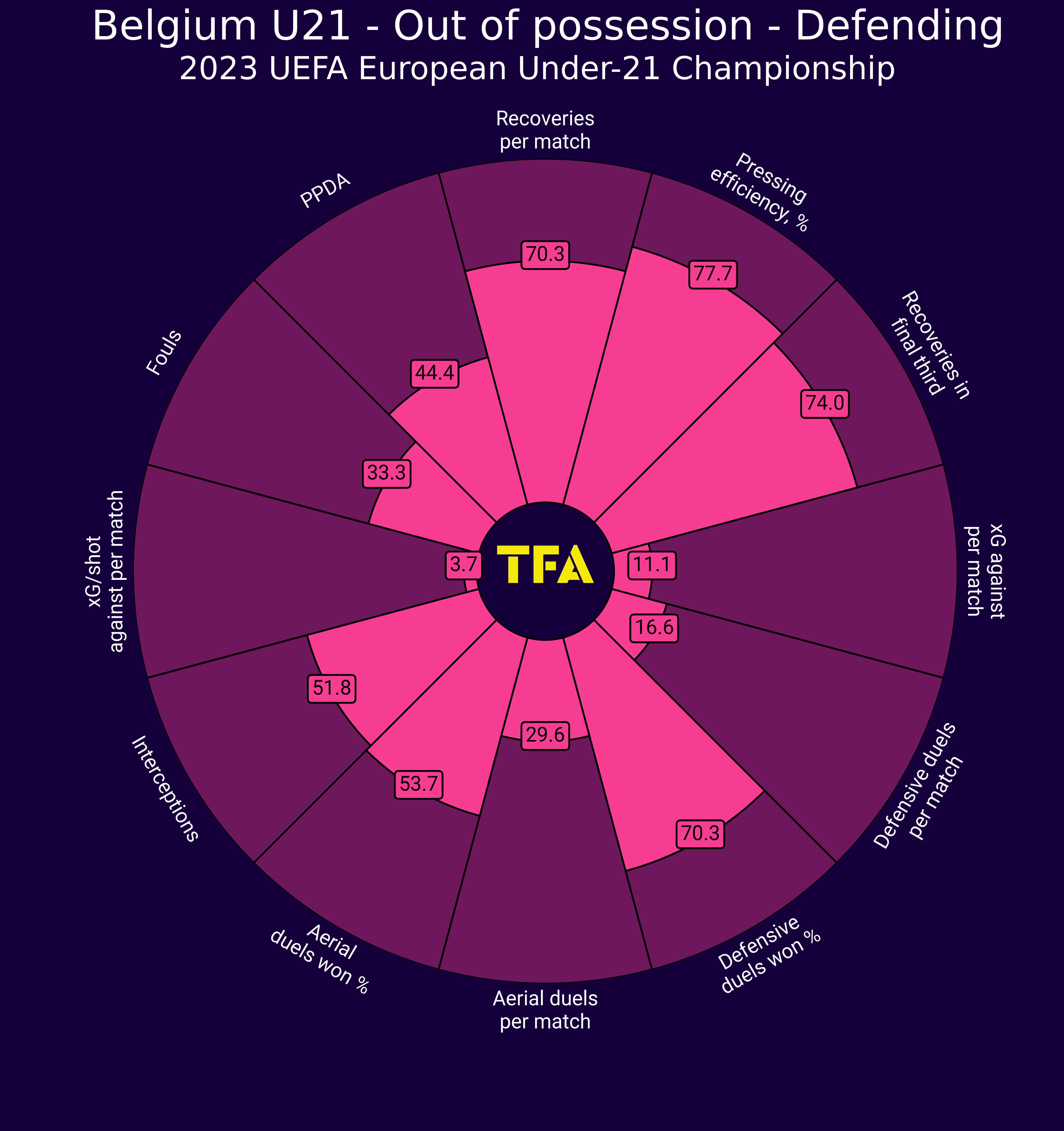
In terms of defensive statistics, the team’s interceptions rank in the 51.8 percentile, indicating their ability to disrupt the opponent’s passing and regain possession. Their PPDA (Passes Per Defensive Action) ratio stands at 44.4, suggesting a moderate level of pressing intensity, with a lower number indicating a more aggressive approach. Moreover, they engage in an average of 29.6 aerial duals per game, showcasing their involvement in aerial challenges.
The team’s pressing efficiency is noteworthy, ranking in the 77.7 percentile. This indicates their effectiveness in applying pressure on the opposition and forcing turnovers. Additionally, their recoveries in the final third stand at the 74th percentile, highlighting their ability to regain possession in advanced areas, which can lead to quick attacking opportunities.
Defensively, Belgium varies between mid-block and low-block with 5-4-1 or 5-3-2.
The Young Devils consistently emphasise the importance of maintaining a tight and unified defensive block, ensuring that players work together cohesively to create a solid defensive structure. This collective effort aims to minimise spaces and effectively deny the opposition any room to exploit, but they occasionally have defensive positioning issues.

Their defensive issues can manifest in various forms, such as instances of poor organisation that lead to noticeable gaps between players for the opponents to exploit, as well as a lack of discipline exhibited when players fail to track the movement of their opponents or neglect their defensive responsibilities.
As the wide centre-back in possession determines the shift from a three-backline to a four, here below the right wing-back has the freedom to adjust himself in the first or second line, depending on the situation.

The team employs a high-pressing strategy intermittently rather than continuously. This approach involves selectively applying pressure on the opposition at specific moments, aiming to disrupt their build-up play and regain possession in dangerous areas.
When applying the high-pressing approach, they seek to direct the play sideways and then press aggressively like the below graphics.
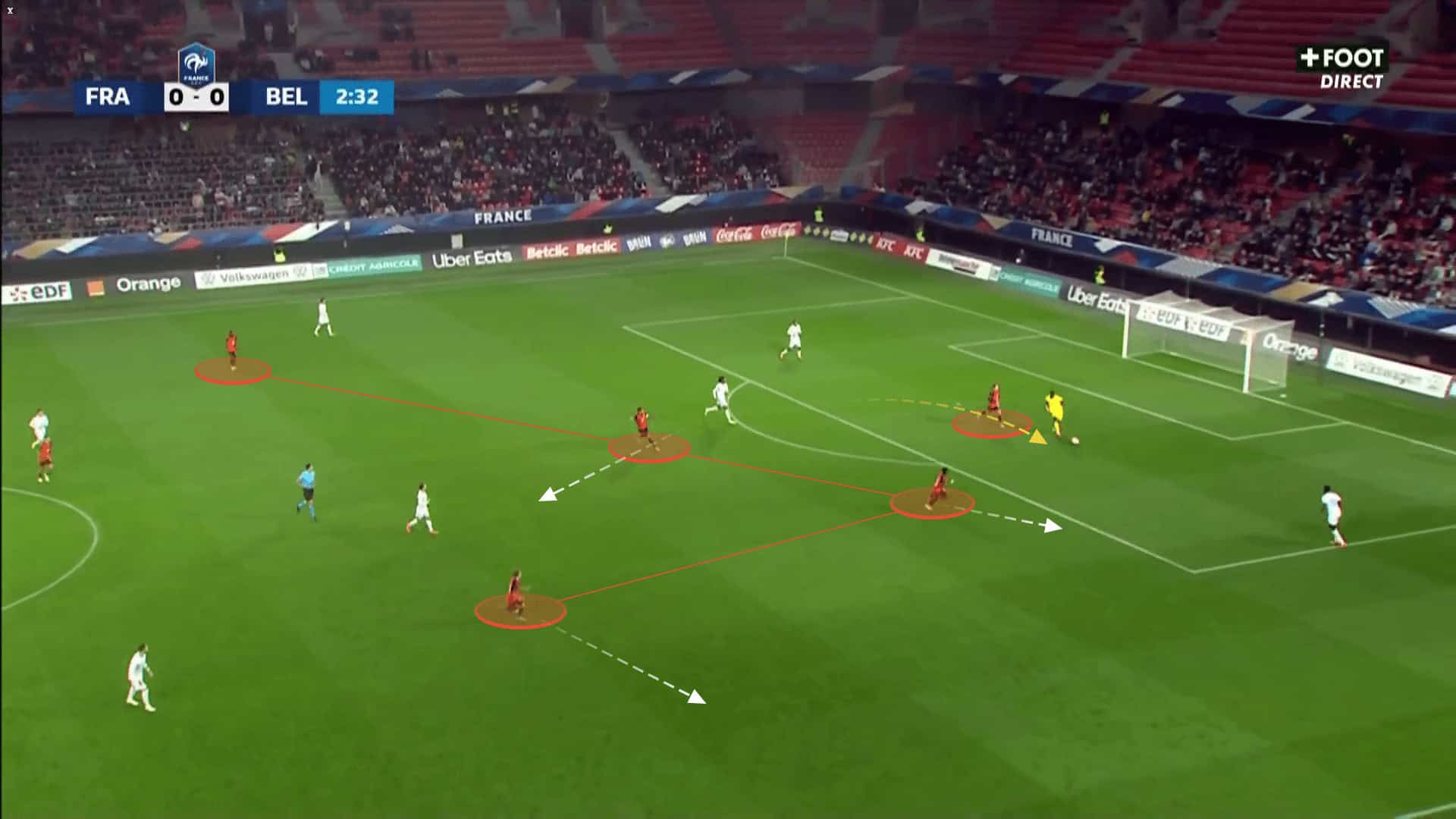
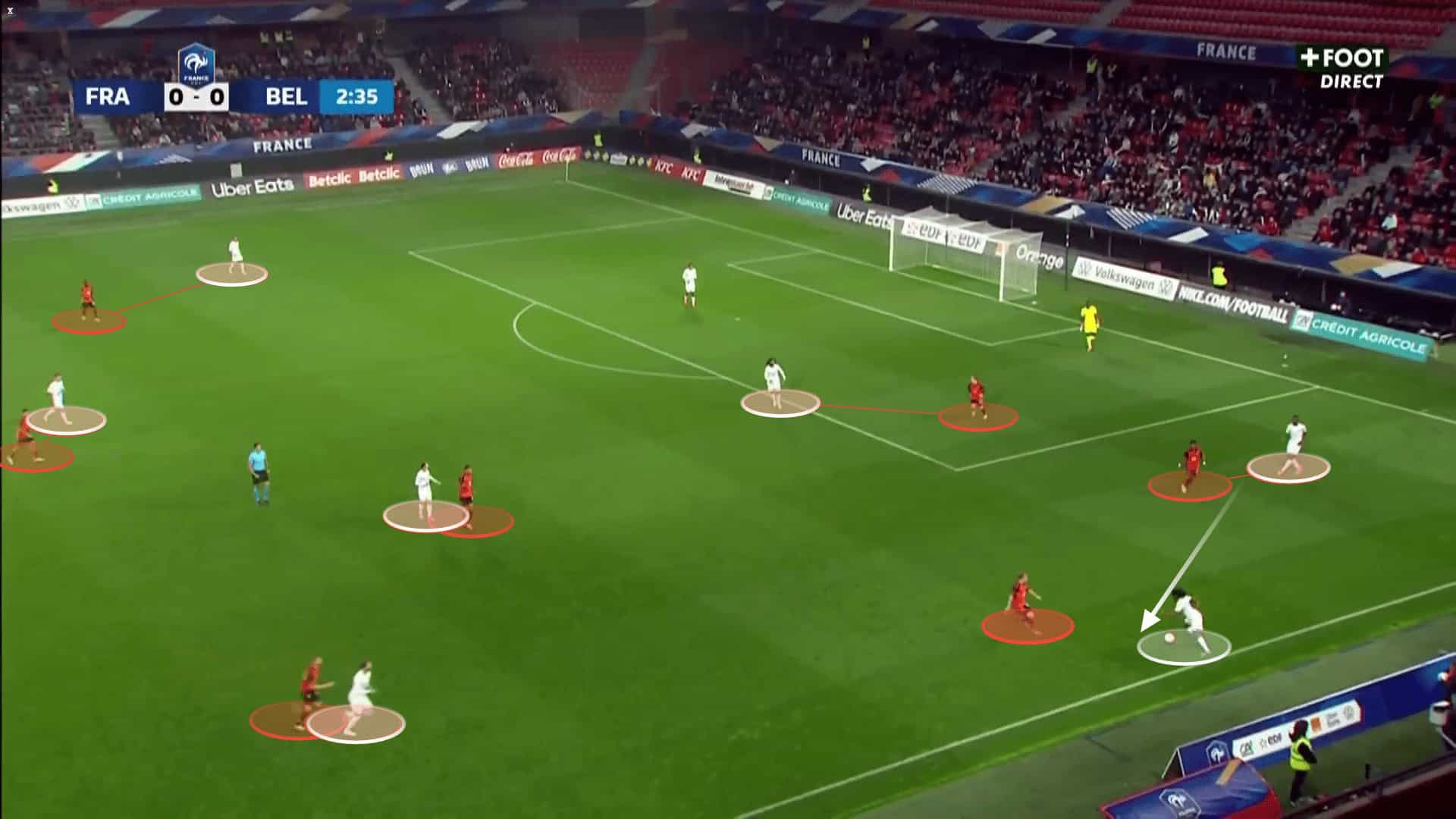
When the team press high, despite the pace of the attacking trio, the pressure sometimes is not effective with intensity, as they have 15.2 PPDA in 2023 compared to 11.81 for the competitors, as per Wyscout.

Transitions
Transitions play a crucial role in Belgium’s playing style, particularly due to the strengths of their attacking players, who possess pace and agility. The team prioritise a rapid counter-attacking approach, aiming to swiftly advance towards the opponent’s goal once they regain possession. This strategy allows for freedom of movement and the effective spreading of players across the field.
Players like Doku, Largie Ramazani, Michel Ange Balikwisha, and Yorbe Vertessen are key contributors during these transitional phases. Their individual skills and attributes make them essential assets for Belgium in quickly transitioning from defence to attack. Their speed, technical ability, and ability to find spaces enable the team to swiftly penetrate the opposition’s defensive lines and create scoring opportunities.
Belgium’s emphasis on quick transitions and utilizing the strengths of their attacking players is a key factor in their ability to capitalise on turnovers and launch effective counterattacks. These players are instrumental in executing these transitions with efficiency and effectiveness, providing a dynamic and threatening attacking force for the team.
Defenders
The defensive line plays a crucial role in Belgium’s team, particularly in facilitating the quick transition of the ball from the back. Players such as Ignace Van der Brempt, Ewoud Pletinckx, and Koni De Winter are vital components of this defensive setup. They possess the skills and vision necessary to initiate rapid ball movement from deep positions, aiding the team in launching swift counterattacks.
Additionally, Ameen Al-Dakhil is an important player who provides depth and serves as a key difference-maker from the bench.
Midfielders
The midfield in Belgium’s system plays a dynamic and significant role due to its fluidity and awareness. The team often deploys two pivots in midfield, which can take different forms. It could involve a pivot alongside an attacking number 8 or two defensive midfielders (straight sixes) to provide stability and secure larger spaces.
Players such as Aster Vranckx, Anass Zaroury, Eliot Matazo, and Roméo Lavia contribute to the midfield’s effectiveness. They possess the required skills and understanding to dictate the tempo of the game, provide defensive cover, and contribute to the team’s attacking play.
In terms of width, Maxim De Cuyper and Matisse Samoise play an important role in stretching the field. Their positioning and movement as wide players provide width and create space for the team’s attacking manoeuvres.
Attackers
The Belgian coach places great emphasis on utilizing fast players in the attacking positions, aligning with the team’s playing style. Players such as Jérémy Doku, Largie Ramazani, Balikwisha, and Vertessen are specifically chosen for their speed and quickness.
By relying on fast players in the attack, the Belgian coach aims to maximise the team’s ability to break through defensive lines and create goal-scoring chances. The combination of speed, technical ability, and agility in the attacking positions provides a threatening dynamic for any opposition.
Key player
Largie Ramazani, the former Manchester United man and current Almería player, is poised for a breakthrough in his career. The upcoming tournament presents a significant opportunity for him to showcase his abilities, particularly because the team’s playing style aligns perfectly with his strengths. Moreover, the coach has demonstrated increased reliance on Ramazani in recent times.
With the team’s playing method being well-suited to his skills, Ramazani has the chance to display his full potential on the international stage. The coach’s growing trust in him indicates that he will have an important role to play in the team’s tactics and attacking strategies.
Ramazani’s individual statistics showcase his impressive contributions to various aspects of the game. He averages a relatively high number of progressive passes per 90 minutes, indicating his ability to play forward passes that advance his team up the field effectively. With a high average of dribbles per 90 minutes, he exhibits exceptional skill and confidence in taking on opponents and successfully manoeuvring past them.
In defensive duels, Ramazani stands out with a rating of 97, highlighting his prowess in engaging in physical battles and coming out on top. Additionally, his dangerous passes statistic ranks at the 62.63 percentile, indicating his ability to execute passes that pose a significant threat to the opposing defence, potentially creating goalscoring opportunities for his team.
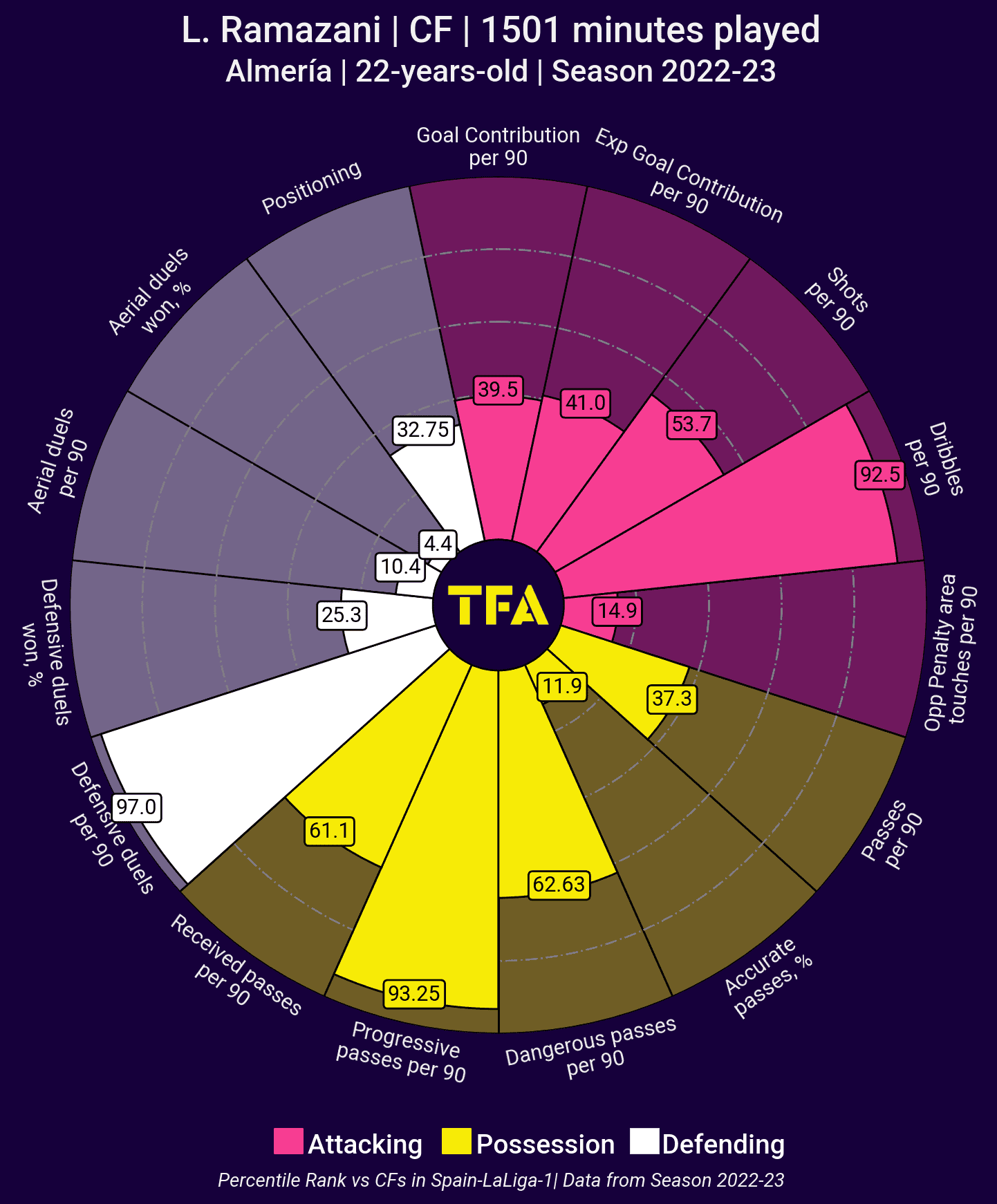
Tournament prediction
Belgium enter the tournament with a talented team, although they may not be considered among the top favourites. Given their absence in previous editions, a successful campaign for The Young Devils would be to reach the advanced stages of the tournament.
Considering their lack of recent participation, making it far in the tournament would be seen as a notable achievement. It would demonstrate the progress and potential of the team, as well as the ability to compete against strong opponents. While they may not be seen as outright contenders, the tournament presents an opportunity for Belgium to prove themselves and make a statement.
Success for The Young Devils in this context would involve surpassing expectations, showcasing their capabilities, and potentially making a deep run in the competition. It would be a positive step forward for the team and a source of pride for the Belgian fans, regardless of the ultimate outcome.

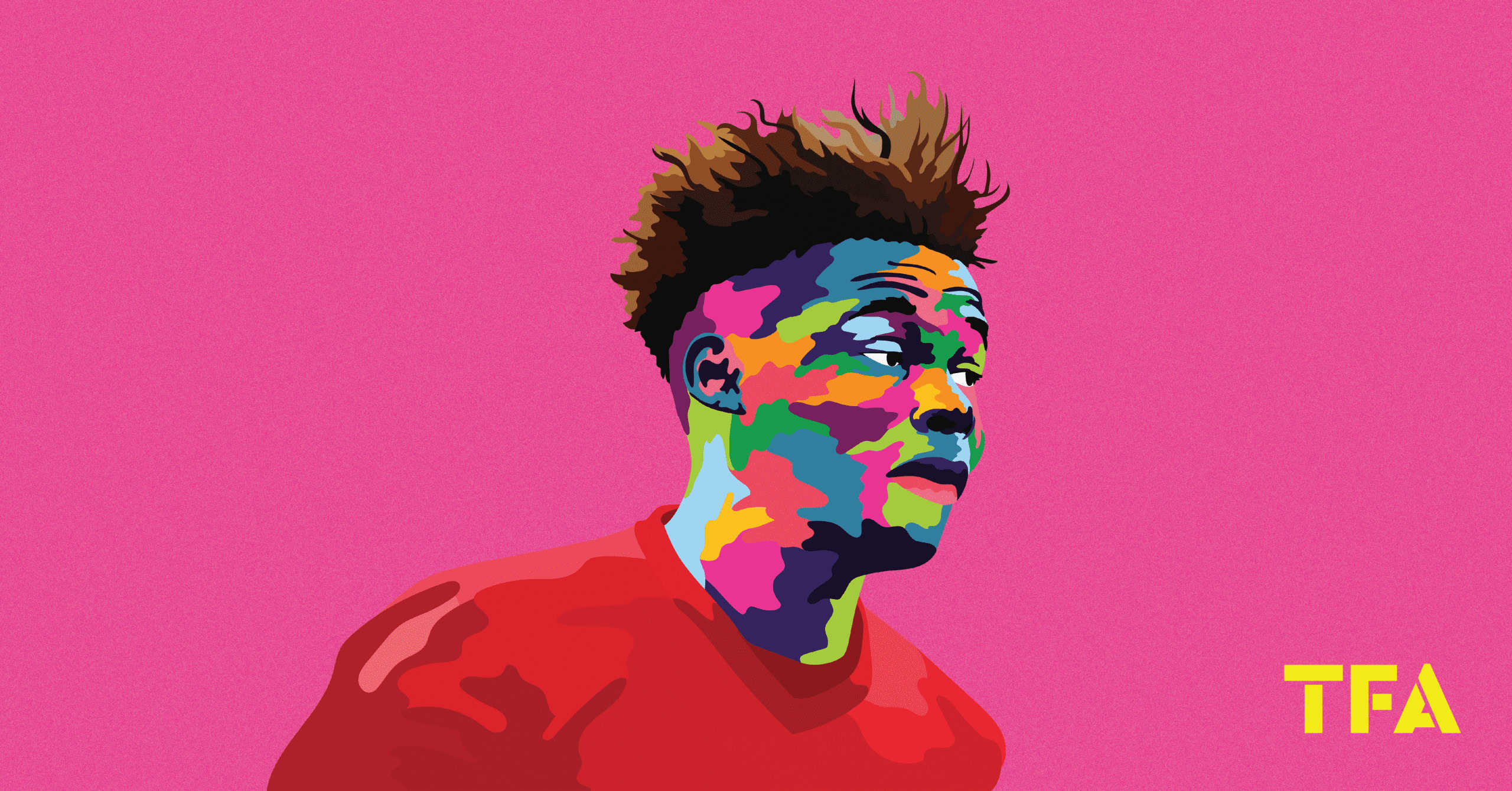



Comments